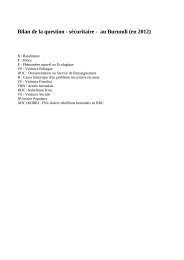Q3 Q4
g8iBkai
g8iBkai
Create successful ePaper yourself
Turn your PDF publications into a flip-book with our unique Google optimized e-Paper software.
fran · q2 2016<br />
Trend<br />
Quarterly detections of illegal<br />
border-crossing, 2014–2016<br />
Number<br />
100 000<br />
50 000<br />
500 000<br />
Central<br />
Mediterranean<br />
route<br />
Nationalities<br />
Main nationalities<br />
of illegal border-crossers<br />
Q2 2016<br />
400 000<br />
Western<br />
Balkan<br />
300 000<br />
200 000<br />
100 000<br />
Western<br />
Balkan<br />
route<br />
Western<br />
Mediterranean<br />
Central<br />
Mediterranean<br />
Kosovo*<br />
Albania<br />
Eastern<br />
Mediterranean<br />
Syria<br />
Iraq<br />
Afghanistan<br />
500 000<br />
400 000<br />
300 000<br />
Sudan<br />
200 000<br />
Eritrea<br />
100 000<br />
<strong>Q4</strong> Q1 Q2 <strong>Q3</strong> <strong>Q4</strong> Q1 Q2<br />
2014 2015 2016<br />
Eastern<br />
Mediterranean<br />
route<br />
Guinea<br />
Côte d'Ivoire<br />
Nigeria<br />
ings on the Western Balkan route. On the<br />
other hand, on the Eastern Mediterranean<br />
route every fifth registered irregular migrant<br />
was an Afghan national, while on the Western<br />
Balkan route, almost every second detection<br />
was related to this nationality.<br />
High irregular migration flows on the<br />
Central Mediterranean route<br />
The decline in irregular migration in the Eastern<br />
Aegean Sea and the Western Balkans<br />
has made the Central Mediterranean route<br />
the most important one in Q2 2016 in terms<br />
of the number of irregular migrants. In fact,<br />
51 450 people were detected in an attempt<br />
to reach the EU by making a dangerous sea<br />
crossing, 14% less than during Q2 2015, but<br />
174% more than in Q1 2016, when adverse sea<br />
conditions made the crossing extremely difficult.<br />
The detections were almost exclusively<br />
made as part of Search and Rescue operations<br />
following a distress call on a satellite<br />
phone, mostly made from migrant boats.<br />
Assets deployed in the Joint Operation EPN<br />
Triton have also registered a change in relative<br />
shares of departure countries: In the<br />
second quarter of 2015, 92% of all migrants<br />
detected in the Central Mediterranean departed<br />
from Libya, while only 4% came from<br />
Egypt. However, the share of migrants coming<br />
from Egypt increased to 14%, while less<br />
than three-quarters of all migrants trying<br />
to reach Italy had left from Libya.<br />
The shift was mainly caused by migrants<br />
from the Horn of Africa, who increasingly<br />
avoided Libya as a transit country due to its<br />
deteriorating security situation and decided<br />
instead to take the route through Egypt, but<br />
also by an increasing number of Egyptians<br />
leaving their country. In fact, more than onethird<br />
of the migrants departing from Egypt<br />
in Q2 2016 came from the Horn of Africa<br />
and 31% were Egyptian nationals. In contrast,<br />
migrant boats departing from Libya<br />
were mostly boarded by West African nationals.<br />
Every fifth migrant who departed<br />
from Libya in the second quarter of 2016<br />
was a Nigerian national.<br />
Detections of irregular migration to<br />
Spain higher than one year ago<br />
On the Western Mediterranean route, Spain<br />
reported the highest irregular migratory<br />
pressure of any second quarter since FRAN<br />
data collection began. With almost 2 000<br />
detections, the number of illegal bordercrossings<br />
was 15% higher than in Q2 2015<br />
and 42% higher than during the first quarter<br />
of 2016. This growth was mostly due to<br />
a greater number of people trying to cross<br />
the sea border from Morocco to Spain, especially<br />
Guineans and Ivorians, whose number<br />
increased by 93% and 146% respectively,<br />
compared with the same period of 2015.<br />
These two nationalities were also the most<br />
commonly reported nationalities of the migrants<br />
detected on the Western African<br />
route from Morocco to the Canary Islands,<br />
where the number of detected illegal border-crossings<br />
slightly increased in Q2 2016.<br />
In contrast, at the land border between Morocco<br />
and the Spanish exclaves of Ceuta and<br />
Melilla, the number of detected illegal border-crossings<br />
decreased from almost 300<br />
in Q2 2015 to slightly more than 100 during<br />
the reference period.<br />
Fewer detections of illegal bordercrossing<br />
from Albania to Greece<br />
In Q2 2016, the Greek authorities reported<br />
the lowest number of illegal border-crossings<br />
on the circular route from Albania since<br />
2011. At the eastern borders, detections of illegal<br />
border-crossing amounted to 370 detections<br />
in Q2 2016, which represents a 27%<br />
decrease compared to Q2 2015. For the first<br />
time, the highest number of illegal bordercrossings<br />
on this route was reported at the<br />
border between the Russian Federation and<br />
Latvia, of which 78% were related to Vietnamese<br />
national.<br />
9 of 37






